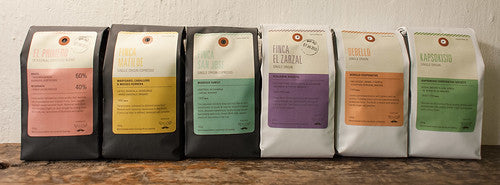Many of you would probably have bought something because of the beautiful packaging while hoping that the product inside was also good in its own way. Since the start of our otherwise short history, we always felt that our retail coffee bags were a little lacking in appeal, starting from the early days when we would scribble the name of the coffee farm and country of origin together with hand-stamping our logo and the roast date. As the roastery stabilised, we designed more rubber stamps to insert more information about the coffees that we have lovingly roasted and packed in the bags. But we were not quite happy with how it looked; the kraft bags crumple very easily, the ink smudges on contact with moisture, and most important of all, it lacked details of the coffee which we wanted to share with our customers.
So we went on another sourcing adventure, first looking for packaging that is friendlier to Mother Earth, something that can probably disintegrate by itself over time, so that drinking coffees doesn’t end up adding heaps of rubbish to ever-growing landfills. We did find one that worked as it says - self biodegradable over time, pretty amazing right! But there is a catch, one has to remove the one-way valve and tin tie before disposing it into your rubbish. In additional, due to the material type, we will not be able to seal the coffees air tight after roasting, meaning the coffees are quite easily subject to the brutality of our hot and humid weather. We figured this will not work, and we moved on.
We pushed our green aspirations down the priority list and found a sturdier bag, and focused our attention on the labels instead. We took a structured and transparent approach in listing down every information that we want to share about our coffees and filter them through what’s important or plain useful, in our opinion.
All coffees come in two distinct coloured bags - black or white. Black packaging are for coffees that are roasted to be better enjoyed as espresso, whereas white denotes coffees better enjoyed as brewed coffee. Simple, just like our coffee menu! Each origin is also differentiated by a different colour label, filled with information that is clear and concise, but yet easy on the eye.
In a nutshell, the label can be broken down as:
1. Name of Coffee
Typically the name of the farm, but could also refer to the locality, the mill or the cooperative where the coffee comes from.
2. The Producer
Often the name of the farmer himself/herself, but could also refer to the cooperative or the collective of farms or small holders.
3. The Origin
Town, region and country.
4. Varietals & Processing Method
A little technical but generally refers to the sub-species of the Arabica coffee varietal and how the coffees were processed after harvest.
5. Altitude
“masl” refers to “meters above sea level”, in case you like to know how high the coffee was grown.
6. Tasting Notes
A brief on what we get through various tastings of the coffee, providing an intro to how the coffee might taste in the cup. This should not be taken as a definite guide to how the coffee should taste but rather as a starting guide to enjoy the coffee the way we did.
7. Weight
Primarily to highlight the different size of the packaging for the seasonal espresso blend compared to other coffees which comes in 250g bags.
8. Roast Date
One of the most important information of all, and we always recommend to use the coffee within 4 weeks from roast date, better if earlier due to our tropical conditions.

For our seasonal espresso, we decided on an even simpler approach by breaking down the components of the blend and getting you started with what we taste in the cup!
As always, we are open to your feedback and hope that you will enjoy the coffee even more with this refresh of the packaging.
